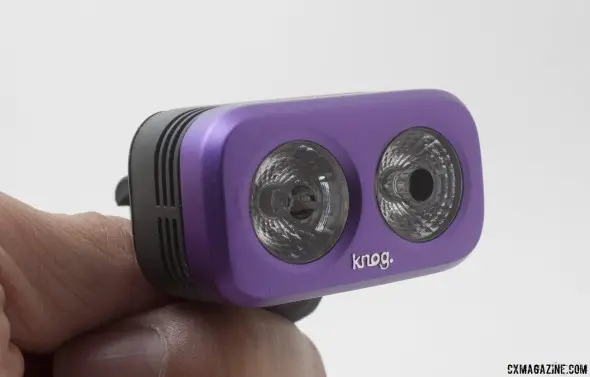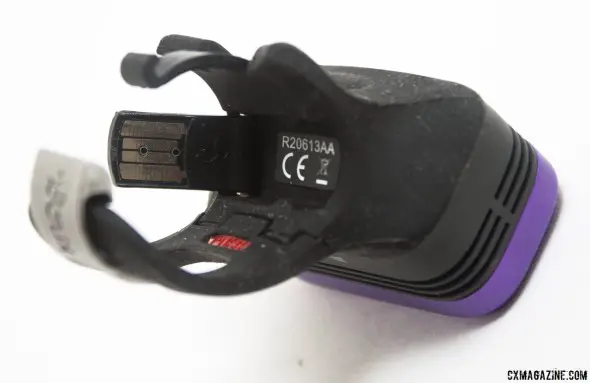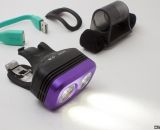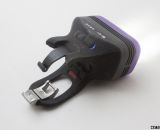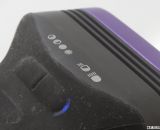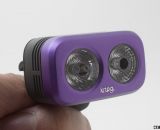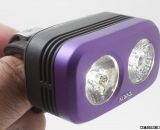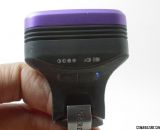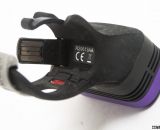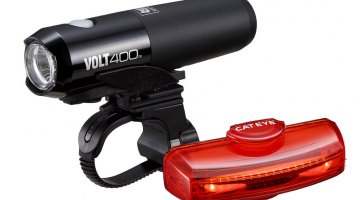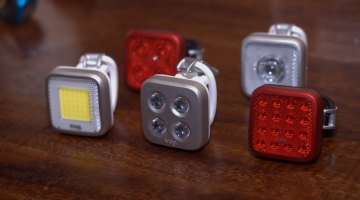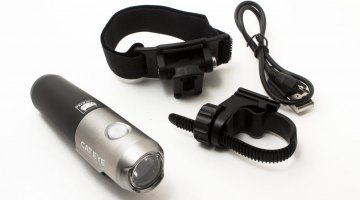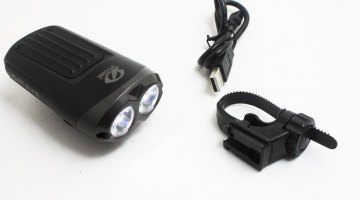With the dark evenings following the end of Daylight Savings, we’re trying to bring the light back into your cyclocross training with some night riding tips and ongoing light reviews. If you haven’t seen them yet, also see our guidelines on what to look for in a bike light for cyclocross training and some night riding tips.
Knog Road Blinder 2 LED Bicycle Headlight
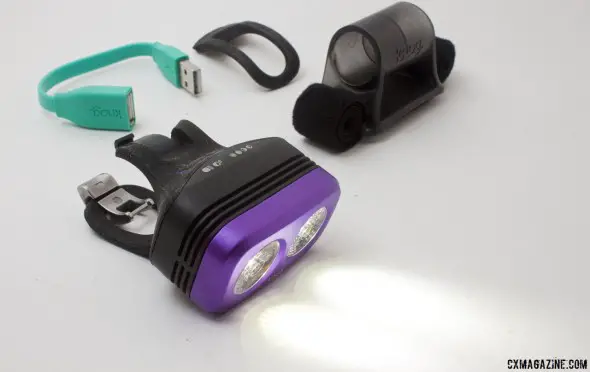
Knog Road Blinder 2 LED bike headlight is light, compact, and surprisingly bright. © Cyclocross Magazine
Knog was founded in Australia in 2003 with the goal of developing unique, innovative bicycle electronics and accessories. The company describes itself as “a team of creative designers and engineers who refuse to conform to anyone or anything” and a group that boasts “ferociousness to smash the mold, challenge the status quo, and revolutionize the way we think about lights and locks.”
Spend any time at their booth at Interbike or CrossVegas, and you’ll see that they really take a different approach to almost everything—look at the CrossVegas course, with an entire back section lit up by a line of Knog lights mounted on course posts, for example. And the Knog Road Blinder 2 LED light is another perfect example of this.
While most of the lights we’re reviewing take on a similar form factor (resembling the recently-reviewed CatEye Nano Shot Plus), with two LEDs, a large, built-in battery, and an above-the-bar mounting system, the Road Blinder 2 looks nothing like them.
The small, two-beam light fits well within the palm of your hand, weighs just 78g (less than half the weight of other headlamps we’re reviewing), has a built-in rubber strap-based handlebar clamp that places the light in front of the handlebar, and comes in four colors.
The Knog Road Blinder is light, compact, doesn’t have cables or moving parts on the mount to come loose, and completely waterproof. What’s not to like? Could it be the ultimate cyclocross light?
Some people might look at the 200 lumens spec and write this light off as not being bright enough. But as we’ve said repeatedly, there’s so much more to a light than its rated lumens. Don’t judge a book by its cover, don’t judge a light by its lumens!
Snap the Knog Road Blinder 2 onto your handlebar, hit the road or trail, and you’ll be amazed how bright it really is. Knog did a great job of focusing that light into a highly usable beam pattern. On high, the two beams join to form a medium-sized circular beam with great brightness. There’s just little peripheral light, which means not much light is wasted on areas you’re not focusing on. Our camera’s light meter verified that the bright spot of the 200 lumen Road Blinder 2’s beam is actually brighter than another 1200 lumen light we tested, proof that beam pattern determines brightness as much as lumens.
At a nighttime cyclocross practice, the Knog Road Blinder 2 was plenty bright enough to light up the course and the trail, but just didn’t leave much light to shine on the lone heckler that showed up. It wasn’t until someone with a much brighter light rolled up behind me (casting my shadow in front of me) did I ever feel like I needed something brighter.
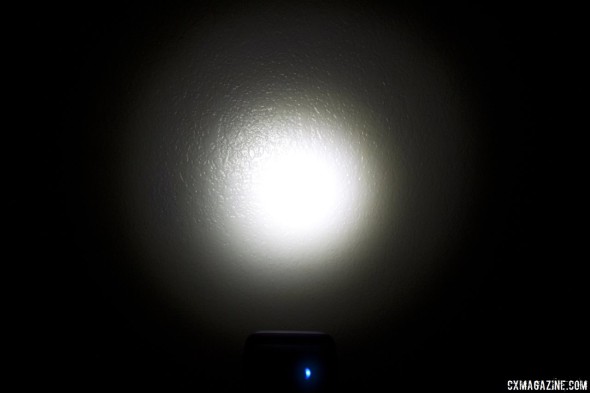
Knog Road Blinder 2 LED bike headlight focuses the lumens into a circular pattern with little peripheral light. © Cyclocross Magazine
I’ve even mountain biked with an early Road Blinder 2 pre-production model after my main light unexpectedly died, and felt confident on technical but relatively slow descents with just the 200 lumens from the Knog Road Blinder 2 LEDs.
The small form factor has its compromises of course, as the light is rated at “just” 200 lumens, and the small battery limits the light to just one hour on full brightness—probably shorter than the average cyclocross practice if you leave it on the whole time, and shorter than most night road or trail rides. Thus if it’s your main form of light for a ride that starts and ends in the dark, you’ll often want more (battery) juice, or a spare light to switch!
As a commuter light, with a primary purpose of making you visible, the Road Blinder 2 does just fine, and on a single beam blinking mode, you should be able to extract almost six hours out of the battery. But at that setting, it’s not exactly blinding (not that we encourage blinding anyone, especially drivers!).
Due to the battery limitations, the Road Blinder 2’s sweet spot might be for evening rides or practices that start in the daylight but finish in the dark (or early morning rides that do the reverse). In such conditions, you can manage the light’s battery, starting with a flashing mode so you’re seen before dusk, and then using the full brightness to get back home in the dark.
There’s actually eight total light modes available with the Knog Road Blinder 2:
- Narrow Low Beam
- Narrow High Beam
- Wide Low Beam
- Wide High Beam
- Dual Low Beam
- Dual High Beam
- Flashing Alternate
- Flashing-1 LED Steady/1 LED flashing.
Got all that? It’s a lot of permutations to play with in the dark, but thankfully, Knog used a pretty intuitive two-button system where one button controls the Low/High setting and the other rotates through the different light pattern options.The production model even has white icons near the buttons to remind you of their functions, and a small colored LED light near the buttons that tell you whether you’re in low (green) or high (blue) modes.
The wide beam is 22 degrees, and the narrow beam is 15 degrees. It may sound like a big difference, but the difference is pretty subtle in operation. When riding off-road, I typically used it in Dual High Beam mode. Surprisingly, Knog rates all high beam modes at the same one hour burn time. I found real world use to be a bit shorter than that.
The two buttons are easy to operate, but a bit subtle to locate in complete darkness, especially with full finger gloves. It’s also worth noting that although the Knog Road Blinder 2 comes with a helmet mount, the two operational buttons are much harder to use when it’s mounted on your helmet, since tactile feedback is all you have to go on. It is light enough to mount on your helmet, but the high/low indicator and battery level indicator lights are useless when it’s on top of your head.
One of our favorite features of the Road Blinder 2 light is its built-in, flip-out male USB charging plug. If you have a computer around or a phone charger with a full-size USB port, you technically don’t need any cable or adapter to charge up the light. On some computers, especially laptops, you may benefit from the included extension cord, but by raising up my laptop a bit, I could charge the light without any cables. That’s reassuring, knowing how easy it is for some of us to misplace a little adapter or charging cable. On our pre-production model, one side of the hinge for the flip-out USB charging plug came loose, but did not impact my ability to charge the light, and on our production model, the hinge has remained in place.
The light offers a low battery indicator, and when the battery is running low, the light automatically switches from high to low modes. When it’s really low, it will shut off completely. There’s also a novel storage mode, so that if you know you won’t be using the light for a while, the light will drain its battery a bit to the “optimal storage voltage” and then turn off.
The mount included with the light is simple and easy to use and will fit around most handlebars. Knog also includes a longer strap for really oversized bars or odd mounting needs, but we found the stretchy silicone mount to hold in place on bumpy rides, and although our pre-production model’s stainless steel latch would sometimes pop open, we’ve experienced no such trouble on the production Knog Road Blinder 2. Another minor nitpick is that the rubber/silicone material is a magnet for lint, as you can see in the pictures, but you won’t see that at night.
Besides the burn time, the Knog Road Blinder is really an impressive light with a great form factor. If you keep your rides short and don’t do any fast, technical off-road downhills, it could provide all the light you need, while being so light it’s barely noticeable when you have to run the barriers or shoulder your bike. The burn times, unfortunately, are quite limiting for us to declare it the ultimate do-it-all training light.
Thankfully, Knog has already addressed our complaints with the just-released Road Blinder 3 light, a unit that’s a bit larger and offers 50% more light with a 300 lumens output, and longer burn times with a bigger battery. At full brightness, it’s still just an hour, but there’s more beam settings with a new mid beam option. Low beam steady mode is supposed to last four hours, and flashing up to nine hours. All those additions come at just $15 more ($94.95) and 30 extra grams.
Stay tuned as we test the Knog Road Blinder 3 in the near future in our search for the ultimate cyclocross light.
Knog Road Blinder 2 LED Bicycle Headlight Specs:
MSRP: $79.95
Weight: 78g
Lumens: 200
LEDs: 2 CREE XB-D LEDs
Full power burn time: 1 hour
Maximum burn time: 6 hours (flashing)
Different Light modes: 8
Charge time: 5 hours
Charging port: Flip-out male USB plug
Included: Helmet mount and velcro straps, large diameter handlebar strap, USB extension cord
More info: Knog.com.au
Knog Road Blinder 2 Photo Gallery:













